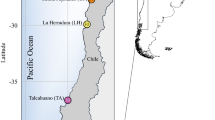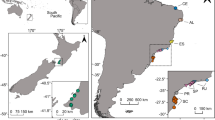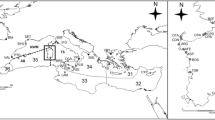Abstract
Background
To grasp the processes of spatial genetic structuring in open and connectable marine environments is the principal study goal in molecular biological studies. Comparative seascape genetics using multiple species are a powerful approach to understand the physical geographic and oceanographic effects on genetic variation. Besides, species-specific ecological traits such as dispersal abilities and habitat specificity are important factors for spatial genetic structuring.
Methods and Results
We focused on the sister marine snail species Tegula kusairo and T. xanthostigma around the Japanese mainland, which have contrasting habitat specificities for wave strength. Tegula kusairo only inhabits sheltered coastal environments, while T. xanthostigma is found mainly on wave-exposed rocky shores facing the open sea. We estimated their genetic diversity indices and levels of population differentiation based on mtDNA. We found that the genetic diversity of T. kusairo was lower than that of T. xanthostigma, while their level of population genetic differentiation was higher than that of T. xanthostigma. Namely, the species specific to weak wave environments had a higher level of population genetic differentiation than the species specific to strong wave action.
Conclusion
Ecological traits linked not only to dispersal abilities but also to habitat specificity can influence genetic variation in a pair of closely related sister species distributed in the same seascape.




Similar content being viewed by others
Data availability
Genbank accession numbers (LC656938–LC657067).
Code availability
Not applicable.
References
Palumbi SR (1994) Genetic divergence, reproductive isolation, and marine speciation. Annu Rev Ecol Syst 25:547–572. https://doi.org/10.1146/annurev.es.25.110194.002555
Nosil P, Schluter D (2011) The genes underlying the process of speciation. Trends Ecol Evol 26:160–167. https://doi.org/10.1016/j.tree.2011.01.001
Meyer CP, Geller JB, Paulay G (2005) Fine scale endemism on coral reefs: Archipelagic differentiation in turbinid gastropods. Evolution (N Y) 59:113–125. https://doi.org/10.1111/j.0014-3820.2005.tb00899.x
White C, Selkoe KA, Watson J et al (2010) Ocean currents help explain population genetic structure. Proc R Soc B Biol Sci 277:1685–1694. https://doi.org/10.1098/rspb.2009.2214
Miller AD, Versace VL, Matthews TG et al (2013) Ocean currents influence the genetic structure of an intertidal mollusc in southeastern Australia—implications for predicting the movement of passive dispersers across a marine biogeographic barrier. Ecol Evol 3:1248–1261. https://doi.org/10.1002/ece3.535
Kelly RP, Palumbi SR (2010) Genetic structure among 50 species of the northeastern pacific rocky intertidal community. PLoS ONE. https://doi.org/10.1371/journal.pone.0008594. 5:
Bernardi G, Ramon ML, Alva-Campbell Y et al (2014) Darwin’s fishes: Phylogeography of Galápagos Islands reef fishes. Bull Mar Sci 90:533–549. https://doi.org/10.5343/bms.2013.1036
Tenggardjaja KA, Bowen BW, Bernardi G (2018) Comparative phylogeography of widespread and endemic damselfishes in the Hawaiian Archipelago. Mar Biol 165:1–21. https://doi.org/10.1007/s00227-018-3395-y
Selkoe KA, Watson JR, White C et al (2010) Taking the chaos out of genetic patchiness: Seascape genetics reveals ecological and oceanographic drivers of genetic patterns in three temperate reef species. Mol Ecol 19:3708–3726. https://doi.org/10.1111/j.1365-294X.2010.04658.x
Cowen RK, Sponaugle S (2009) Larval dispersal and marine population connectivity. Annu Rev Mar Sci 1:443–466. https://doi.org/10.1146/annurev.marine.010908.163757
Jaenike J, Holt RD (1991) Genetic variation for habitat preference: evidence and explanations. Am Nat. https://doi.org/10.1086/285140
Rocha LA, Bass AL, Robertson DR, Bowen BW (2002) Adult habitat preferences, larval dispersal, and the comparative phylogeography of three Atlantic surgeonfishes (Teleostei: Acanthuridae). Mol Ecol 11:243–251. https://doi.org/10.1046/j.0962-1083.2001.01431.x
Robuchon M, Le Gall L, Mauger S, Valero M (2014) Contrasting genetic diversity patterns in two sister kelp species co-distributed along the coast of Brittany, France. Mol Ecol 23:2669–2685. https://doi.org/10.1111/mec.12774
Wort EJG, Chapman MA, Hawkins SJ et al (2019) Contrasting genetic structure of sympatric congeneric gastropods: Do differences in habitat preference, abundance and distribution matter? J Biogeogr 46:369–380. https://doi.org/10.1111/jbi.13502
Burrows MT (2012) Influences of wave fetch, tidal flow and ocean colour on subtidal rocky communities. Mar Ecol Prog Ser 445:193–207. https://doi.org/10.3354/meps09422
Gaylord B (2000) Biological implications of surf-zone flow complexity. Limnol Oceanogr 45:174–188. https://doi.org/10.4319/lo.2000.45.1.0174
Hurd CL (2000) Water motion, marine macroalgal physiology, and production. J Phycol 36:453–472. https://doi.org/10.1046/j.1529-8817.2000.99139.x
Tam JC, Scrosati RA (2014) Distribution of cryptic mussel species (Mytilus edulis and M. trossulus) along wave exposure gradients on northwest Atlantic rocky shores. Mar Biol Res 10:51–60. https://doi.org/10.1080/17451000.2013.793809
Selkoe KA, D’Aloia CC, Crandall ED et al (2016) A decade of seascape genetics: Contributions to basic and applied marine connectivity. Mar Ecol Prog Ser 554:1–19. https://doi.org/10.3354/meps11792
Hellberg ME (1998) Sympatric sea shells along the sea’s shore: the geography of speciation in the marine gastropod Tegula. Evolution (N Y) 52:1311–1324. https://doi.org/10.2307/2411301
Sasaki T (2017) Family Tegulidae. In: Okutani T (ed) Marine mollusks in Japan, 2nd edn. Tokai University Press, Tokya
Sasaki R (1985) Larval identification and occurrence of ezo abalone, Haliotis discus hannai, in the adjacent waters of Kesennuma Bay, Miyagi Prefecture. Suisan Zoushoku 32:199–206
Moran AL (1997) Spawning and larval development of the black turban snail Tegula funebralis (Prosobranchia: Trochidae). Mar Biol 128:107–114. https://doi.org/10.1007/s002270050074
Yamazaki D, Hirano T, Uchida S et al (2019) Relationship between contrasting morphotypes and the phylogeny of the marine gastropod genus Tegula (Vetigastropoda: Tegulidae) in East Asia. J Molluscan Stud 85:92–102. https://doi.org/10.1093/mollus/eyy055
Yamazaki D, Hirano T, Chiba S, Fukuda H (2020) A new replacement name for Chlorostoma lischkei Pilsbry, 1889 (not of Tapparone-Canefri, 1874) (Vetigastropoda: Trochida: Tegulidae). Molluscan Res 40(4):327–344
Griekspoor A, Groothuis T (2005) 4peaks. Ver. 1.7.1. http://nucleobytes.com/4peaks/. Accessed 5 Nov 2021
Edgar RC (2004) MUSCLE: Multiple sequence alignment with high accuracy and high throughput. Nucleic Acids Res. https://doi.org/10.1093/nar/gkh340
Excoffier L, Lischer HEL (2010) Arlequin suite ver 3.5: A new series of programs to perform population genetics analyses under Linux and Windows. Mol Ecol Resour 10:564–567. https://doi.org/10.1111/j.1755-0998.2010.02847.x
Leigh JW, Bryant D (2015) POPART: Full-feature software for haplotype network construction. Methods Ecol Evol 6:1110–1116. https://doi.org/10.1111/2041-210X.12410
Bandelt H, Forster P, Röhl A (1999) Median-joining networks for inferring intraspecific phylogenies. Mol Biol Evol 16:37–48
Rogers A, Harpending H (1992) Population growth makes waves in the distribution of pairwise genetic differences. Mol Biol Evol. https://doi.org/10.1093/oxfordjournals.molbev.a040727
Tajima F (1989) Statistical method for testing the neutral mutation hypothesis by DNA polymorphism. Genetics 123:585–595
Fu YX (1997) Statistical test of neutrality of mutation against population growth, hitchhiking and background selection. Genetics 147:915–925
Kojima S, Segawa R, Hayashi I (1997) Genetic differentiation among populations of the Japanese turban shell Turbo (Batillus) cornutus corresponding to warm currents. Mar Ecol Prog Ser 150:149–155. https://doi.org/10.3354/meps150149
Hirase S, Ikeda M, Kanno M, Kijima A (2012) Phylogeography of the intertidal goby Chaenogobius annularis associated with paleoenvironmental changes around the Japanese Archipelago. Mar Ecol Prog Ser 450:167–179. https://doi.org/10.3354/meps09584
Yamazaki D, Miura O, Ikeda M et al (2017) Genetic diversification of intertidal gastropoda in an archipelago: the effects of islands, oceanic currents, and ecology. Mar Biol. https://doi.org/10.1007/s00227-017-3207-9
Valero M, Destombe C, Mauger S et al (2011) Using genetic tools for sustainable management of kelps: a literature review and the example of Laminaria digitata. Cah Biol Mar 52:467–483. https://doi.org/10.21411/cbm.a.a57922dd
Engel CR, Destombe C, Valero M (2004) Mating system and gene flow in the red seaweed Gracilaria gracilis: effect of haploid-diploid life history and intertidal rocky shore landscape on fine-scale genetic structure. Heredity (Edinb) 92:289–298. https://doi.org/10.1038/sj.hdy.6800407
Helmuth BST, Hofmann GE (2001) Microhabitats, thermal heterogeneity, and patterns of physiological stress in the rocky intertidal zone. Biol Bull 201:374–384. https://doi.org/10.2307/1543615
Fulton CJ, Bellwood DR, Wainwright PC (2005) Wave energy and swimming performance shape coral reef fish assemblages. Proc R Soc B: Biol Sci. https://doi.org/10.1098/rspb.2004.3029
Bejarano S, Jouffray J, Chollett I et al (2017) The shape of success in a turbulent world: wave exposure filtering of coral reef herbivory. Funct Ecol. https://doi.org/10.1111/1365-2435.12828
Hampton SL (2014) Why Carcinus maenas cannot get a grip on South Africa ’ s wave-exposed coastline. Afr J Mar Sci. https://doi.org/10.2989/AJMS.2007.29.1.11.76
Shimabukuro H, Hori M, Yoshimitsu S et al (2012) Genetic differentiation of annual Zostera marina L. growing in Kagoshima Bay, Kagoshima, Japan based on an analysis using microsatellite markers. Nippon Suisan Gakkaishi (Japanese Ed 78:204–211. https://doi.org/10.2331/suisan.78.204
Underwood JN, Richards ZT, Miller KJ et al (2018) Genetic signatures through space, time and multiple disturbances in a ubiquitous brooding coral. Mol Ecol 27:1586–1602. https://doi.org/10.1111/mec.14559
Ni G, Li Q, Kong L, Yu H (2014) Comparative phylogeography in marginal seas of the northwestern Pacific. Mol Ecol 23:534–548. https://doi.org/10.1111/mec.12620
Piñeira J, Quesada H, Rolán-Alvarez E, Caballero A (2008) Genetic discontinuity associated with an environmentally induced barrier to gene exchange in the marine snail Littorina saxatilis. Mar Ecol Prog Ser 357:175–184. https://doi.org/10.3354/meps07278
Acknowledgements
For sampling, providing important information and advice on the present study, we thank Miura, O., Miki, Y., Seo, T., Ye, B., Prozorova, L., Hirano, T., Saito, T., Uchida, S., and Higuchi, K.
Funding
This study was supported by funds from Research Institute of Marine Invertebrates (2017–2018).
Author information
Authors and Affiliations
Contributions
DY conducted the study design, budget acquisition, sample collection, genetic experiments, data analyses and interpretation, and writing the manuscript. SC supervised this study, acquired funds, and wrote the manuscript. The two authors read and approved the final manuscript.
Corresponding author
Ethics declarations
Conflict of interest
The authors declare that there is no conflict of interest.
Ethical approval
Not applicable.
Consent to participate
Not applicable.
Consent for publication
Not applicable.
Additional information
Publisher’s Note
Springer Nature remains neutral with regard to jurisdictional claims in published maps and institutional affiliations.
Rights and permissions
About this article
Cite this article
Yamazaki, D., Chiba, S. Comparing the genetic diversity and population structure of sister marine snails having contrasting habitat specificity. Mol Biol Rep 49, 393–401 (2022). https://doi.org/10.1007/s11033-021-06885-x
Received:
Accepted:
Published:
Issue Date:
DOI: https://doi.org/10.1007/s11033-021-06885-x




